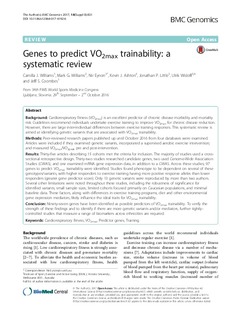| dc.contributor.author | Williams, Camilla J | |
| dc.contributor.author | Williams, Mark G | |
| dc.contributor.author | Eynon, Nir | |
| dc.contributor.author | Ashton, Kevin J | |
| dc.contributor.author | Little, Jonathan P | |
| dc.contributor.author | Wisløff, Ulrik | |
| dc.contributor.author | Coombes, Jeff S. | |
| dc.date.accessioned | 2018-08-22T08:40:56Z | |
| dc.date.available | 2018-08-22T08:40:56Z | |
| dc.date.created | 2018-01-09T08:40:45Z | |
| dc.date.issued | 2017 | |
| dc.identifier.citation | BMC Genomics. 2017, 18 81-110. | nb_NO |
| dc.identifier.issn | 1471-2164 | |
| dc.identifier.uri | http://hdl.handle.net/11250/2558794 | |
| dc.description.abstract | Background
Cardiorespiratory fitness (VO2max) is an excellent predictor of chronic disease morbidity and mortality risk. Guidelines recommend individuals undertake exercise training to improve VO2max for chronic disease reduction. However, there are large inter-individual differences between exercise training responses. This systematic review is aimed at identifying genetic variants that are associated with VO2max trainability.
Methods
Peer-reviewed research papers published up until October 2016 from four databases were examined. Articles were included if they examined genetic variants, incorporated a supervised aerobic exercise intervention; and measured VO2max/VO2peak pre and post-intervention.
Results
Thirty-five articles describing 15 cohorts met the criteria for inclusion. The majority of studies used a cross-sectional retrospective design. Thirty-two studies researched candidate genes, two used Genome-Wide Association Studies (GWAS), and one examined mRNA gene expression data, in addition to a GWAS. Across these studies, 97 genes to predict VO2max trainability were identified. Studies found phenotype to be dependent on several of these genotypes/variants, with higher responders to exercise training having more positive response alleles than lower responders (greater gene predictor score). Only 13 genetic variants were reproduced by more than two authors. Several other limitations were noted throughout these studies, including the robustness of significance for identified variants, small sample sizes, limited cohorts focused primarily on Caucasian populations, and minimal baseline data. These factors, along with differences in exercise training programs, diet and other environmental gene expression mediators, likely influence the ideal traits for VO2max trainability.
Conclusion
Ninety-seven genes have been identified as possible predictors of VO2max trainability. To verify the strength of these findings and to identify if there are more genetic variants and/or mediators, further tightly-controlled studies that measure a range of biomarkers across ethnicities are required. | nb_NO |
| dc.language.iso | eng | nb_NO |
| dc.publisher | BioMed Central | nb_NO |
| dc.rights | Navngivelse 4.0 Internasjonal | * |
| dc.rights.uri | http://creativecommons.org/licenses/by/4.0/deed.no | * |
| dc.title | Genes to predict VO2max trainability: a systematic review | nb_NO |
| dc.type | Journal article | nb_NO |
| dc.type | Peer reviewed | nb_NO |
| dc.description.version | publishedVersion | nb_NO |
| dc.source.pagenumber | 81-110 | nb_NO |
| dc.source.volume | 18 | nb_NO |
| dc.source.journal | BMC Genomics | nb_NO |
| dc.identifier.doi | 10.1186/s12864-017-4192-6 | |
| dc.identifier.cristin | 1538365 | |
| dc.description.localcode | © The Author(s). 2017 Open Access This article is distributed under the terms of the Creative Commons Attribution 4.0 International License (http://creativecommons.org/licenses/by/4.0/) | nb_NO |
| cristin.unitcode | 194,65,25,0 | |
| cristin.unitname | Institutt for sirkulasjon og bildediagnostikk | |
| cristin.ispublished | true | |
| cristin.fulltext | original | |
| cristin.qualitycode | 1 | |

